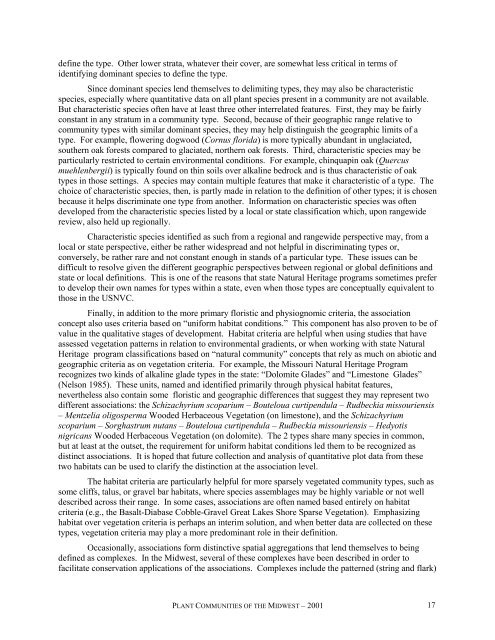Plant Communities of the Midwest - NatureServe
Plant Communities of the Midwest - NatureServe
Plant Communities of the Midwest - NatureServe
Create successful ePaper yourself
Turn your PDF publications into a flip-book with our unique Google optimized e-Paper software.
define <strong>the</strong> type. O<strong>the</strong>r lower strata, whatever <strong>the</strong>ir cover, are somewhat less critical in terms <strong>of</strong><br />
identifying dominant species to define <strong>the</strong> type.<br />
Since dominant species lend <strong>the</strong>mselves to delimiting types, <strong>the</strong>y may also be characteristic<br />
species, especially where quantitative data on all plant species present in a community are not available.<br />
But characteristic species <strong>of</strong>ten have at least three o<strong>the</strong>r interrelated features. First, <strong>the</strong>y may be fairly<br />
constant in any stratum in a community type. Second, because <strong>of</strong> <strong>the</strong>ir geographic range relative to<br />
community types with similar dominant species, <strong>the</strong>y may help distinguish <strong>the</strong> geographic limits <strong>of</strong> a<br />
type. For example, flowering dogwood (Cornus florida) is more typically abundant in unglaciated,<br />
sou<strong>the</strong>rn oak forests compared to glaciated, nor<strong>the</strong>rn oak forests. Third, characteristic species may be<br />
particularly restricted to certain environmental conditions. For example, chinquapin oak (Quercus<br />
muehlenbergii) is typically found on thin soils over alkaline bedrock and is thus characteristic <strong>of</strong> oak<br />
types in those settings. A species may contain multiple features that make it characteristic <strong>of</strong> a type. The<br />
choice <strong>of</strong> characteristic species, <strong>the</strong>n, is partly made in relation to <strong>the</strong> definition <strong>of</strong> o<strong>the</strong>r types; it is chosen<br />
because it helps discriminate one type from ano<strong>the</strong>r. Information on characteristic species was <strong>of</strong>ten<br />
developed from <strong>the</strong> characteristic species listed by a local or state classification which, upon rangewide<br />
review, also held up regionally.<br />
Characteristic species identified as such from a regional and rangewide perspective may, from a<br />
local or state perspective, ei<strong>the</strong>r be ra<strong>the</strong>r widespread and not helpful in discriminating types or,<br />
conversely, be ra<strong>the</strong>r rare and not constant enough in stands <strong>of</strong> a particular type. These issues can be<br />
difficult to resolve given <strong>the</strong> different geographic perspectives between regional or global definitions and<br />
state or local definitions. This is one <strong>of</strong> <strong>the</strong> reasons that state Natural Heritage programs sometimes prefer<br />
to develop <strong>the</strong>ir own names for types within a state, even when those types are conceptually equivalent to<br />
those in <strong>the</strong> USNVC.<br />
Finally, in addition to <strong>the</strong> more primary floristic and physiognomic criteria, <strong>the</strong> association<br />
concept also uses criteria based on “uniform habitat conditions.” This component has also proven to be <strong>of</strong><br />
value in <strong>the</strong> qualitative stages <strong>of</strong> development. Habitat criteria are helpful when using studies that have<br />
assessed vegetation patterns in relation to environmental gradients, or when working with state Natural<br />
Heritage program classifications based on “natural community” concepts that rely as much on abiotic and<br />
geographic criteria as on vegetation criteria. For example, <strong>the</strong> Missouri Natural Heritage Program<br />
recognizes two kinds <strong>of</strong> alkaline glade types in <strong>the</strong> state: “Dolomite Glades” and “Limestone Glades”<br />
(Nelson 1985). These units, named and identified primarily through physical habitat features,<br />
never<strong>the</strong>less also contain some floristic and geographic differences that suggest <strong>the</strong>y may represent two<br />
different associations: <strong>the</strong> Schizachyrium scoparium – Bouteloua curtipendula – Rudbeckia missouriensis<br />
– Mentzelia oligosperma Wooded Herbaceous Vegetation (on limestone), and <strong>the</strong> Schizachyrium<br />
scoparium – Sorghastrum nutans – Bouteloua curtipendula – Rudbeckia missouriensis – Hedyotis<br />
nigricans Wooded Herbaceous Vegetation (on dolomite). The 2 types share many species in common,<br />
but at least at <strong>the</strong> outset, <strong>the</strong> requirement for uniform habitat conditions led <strong>the</strong>m to be recognized as<br />
distinct associations. It is hoped that future collection and analysis <strong>of</strong> quantitative plot data from <strong>the</strong>se<br />
two habitats can be used to clarify <strong>the</strong> distinction at <strong>the</strong> association level.<br />
The habitat criteria are particularly helpful for more sparsely vegetated community types, such as<br />
some cliffs, talus, or gravel bar habitats, where species assemblages may be highly variable or not well<br />
described across <strong>the</strong>ir range. In some cases, associations are <strong>of</strong>ten named based entirely on habitat<br />
criteria (e.g., <strong>the</strong> Basalt-Diabase Cobble-Gravel Great Lakes Shore Sparse Vegetation). Emphasizing<br />
habitat over vegetation criteria is perhaps an interim solution, and when better data are collected on <strong>the</strong>se<br />
types, vegetation criteria may play a more predominant role in <strong>the</strong>ir definition.<br />
Occasionally, associations form distinctive spatial aggregations that lend <strong>the</strong>mselves to being<br />
defined as complexes. In <strong>the</strong> <strong>Midwest</strong>, several <strong>of</strong> <strong>the</strong>se complexes have been described in order to<br />
facilitate conservation applications <strong>of</strong> <strong>the</strong> associations. Complexes include <strong>the</strong> patterned (string and flark)<br />
PLANT COMMUNITIES OF THE MIDWEST – 2001<br />
17
















